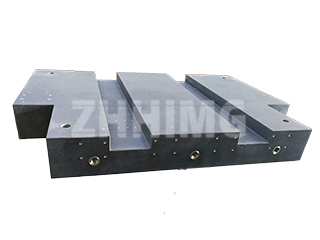In the field of ultra-precision manufacturing, the grinding and polishing of granite surface plates play a decisive role in determining surface flatness, gloss, and overall accuracy. Although granite is one of the hardest and most stable natural materials, achieving the required micrometer-level precision still relies on the careful selection and correct use of polishing liquids and polishing agents.
During the grinding process, these liquids and agents not only influence material removal rates but also affect the surface finish and long-term stability of the granite platform. Selecting the proper type and formulation is therefore essential for achieving optimal results and extending the lifespan of the precision granite component.
In professional applications, the liquids and agents used for granite platform grinding are generally divided into four functional categories: cleaners, abrasives, polishing agents, and sealants.
Cleaners are primarily used to remove contaminants and residues from the granite surface—such as oil, oxide, or fine dust—before and after grinding. Common cleaning solutions include neutral pH cleaners, mildly acidic agents, or alkaline detergents. When using chemical cleaners, operators must control concentration and exposure time to prevent chemical etching or dulling of the granite surface.
Abrasives serve as the key medium for material removal. The abrasive grains cut and level the granite surface to eliminate micro-defects, scratches, and unevenness. The most widely used abrasive materials are alumina, silicon carbide, and high-purity silica compounds. The selection of abrasive type, particle size, and concentration depends on the granite’s hardness and the required surface precision. For fine finishing, abrasives with sub-micron particle sizes are used to achieve ultra-flat surfaces within 1–2 µm flatness tolerance.
Polishing agents are applied after grinding to enhance surface smoothness and gloss. In this stage, the goal is not material removal but refinement of micro-surface texture. Advanced formulations based on polyurethane, acrylic compounds, and chromium oxide are often used to produce a mirror-like finish. The correct balance between pressure, speed, and agent composition is crucial for achieving uniform brightness without compromising precision.
Finally, sealants are applied as a protective layer once polishing is complete. Granite itself is highly resistant to corrosion and temperature variation, but applying a suitable sealant improves resistance to water, oil, and dust while maintaining the platform’s optical and mechanical stability. Professional manufacturers often use polymer or wax-based sealants to ensure long-term protection, especially in high-humidity or laboratory environments.
When performing granite grinding and polishing, operators must ensure a controlled temperature and humidity environment—typically 20 ± 1 °C—to prevent thermal deformation. Using purified water or neutral polishing liquids is also recommended to avoid introducing impurities. Regular maintenance, including cleaning and inspection of the surface plate, helps preserve its accuracy and extend its service life.
In conclusion, achieving a flawless finish on a precision granite surface plate depends on the precise selection and professional use of polishing liquids and agents. Each stage—from cleaning to sealing—requires expertise, attention to detail, and strict control of process parameters. When done correctly, the result is a granite platform with exceptional flatness, smoothness, and durability—ensuring reliable performance for precision measurement and high-end manufacturing applications.
Post time: Nov-13-2025

